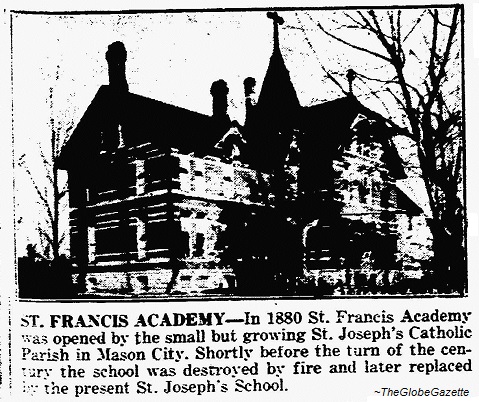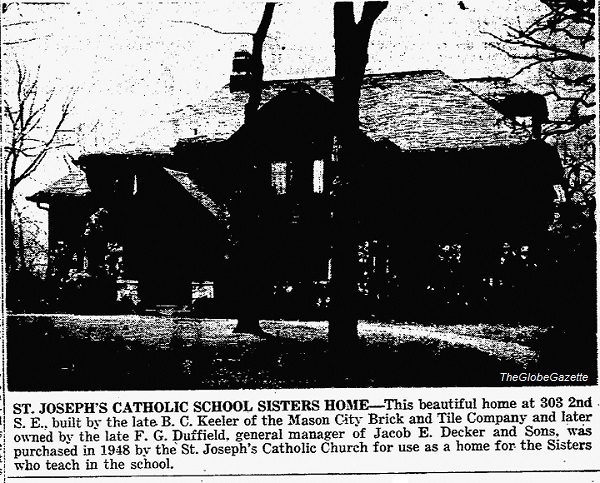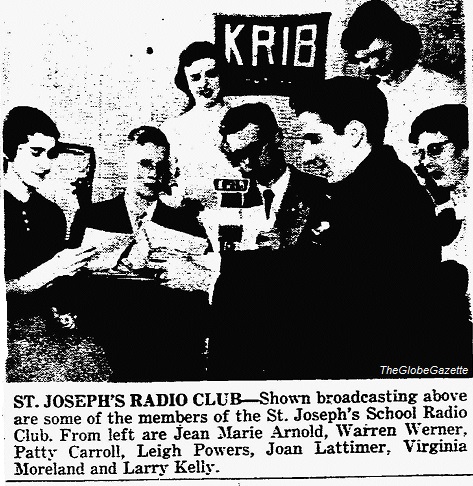


Cerro Gordo County Iowa
Part of the IaGenWeb Project
|
The Globe Gazette
THE STORY of THE SCHOOLS
St. Joseph's Opened School in 1880

Seventy-five years ago the building of the first parochial school at St. Joseph's in Mason City was commenced, through the combined efforts of
the Rev. Michael Carolan and his parishioners, and, on Oct. 15, 1880, the first school, a large, three-story, red brick, veneered building of a distinctly
Gothic structure, was opened for use. This school, known as St. Francis Academy, was staffed by the Sisters of St. Francis from Clinton and had an enrollment ranging from 200 to 250. Twenty years later
the building was destroyed by fire.
After a few years a new three-story, brown brick structure which still [1953] houses the grade school was built [at cost of $35,000**] and on its erection in 1909 the Sisters of the
Presentation of the Blessed Virgin Mary, whose motherhouse is in Dubuque, accepted the invitation to conduct it.
NOTE: When a request came from Father Michael Carolan for Presentation Sisters to take over the educational duties in Mason City, the small number of sisters available prompted Mother Benedict’s reply, “We are sorry to disappoint you, Father, but to supply you with teachers is an impossibility at this time.” However, at the advice and urging of chaplain Father Patrick Leahy, two sisters from among the General Council, with two others taken from their duties at the motherhouse, were assigned to take on this task.
On Sept. 1, 1910, the new school was
opened as a combined boarding and day school of eight grades with a larger than expected enrollment [which required the hiring of a lay teacher for the middle
grades*].
Two years later the high school department was added [with the first class graduating in 1916*]. [In 1919 the school was
remodeled at a cost of $14,000.**] In 1920 the four-year high school was
accredited by the Iowa State Board of Secondary Education and has continued ever since. In 1927, due to increased enrollment, a new wing was added to the school, costing $75,000. This wing contains high school class rooms, library, gymnasium and auditorium. Enrollment gradually increased as the years went on until it reached a peak of 416. At the present [1953] time the faculty consists of 14 Sisters and two assistant priests, the Rev. L. H. Riecks and the Rev. William Arquitt.

In 1948, under the guidance of the present pastor, the Rt. Rev. Msgr. P. F. Malone, the beautiful Duffield residence at 303 Second Street S.E., was purchased, enlarged and remodeled into an ample and modern home for the Sisters on the staff, thus providing more space in the school building for educational facilities. [*This structure, dubbed "The Mansion," housed the sisters from 1949 to 1965 when it was sold and given by the MacNider family to the city; present-day Charles H. MacNider Museum and Art Center. The sisters relocated in a covent established behind the church which featured a chapel with windows designed by Presentation Sister Josita Zieser.]
Courses in Religion Science English, Speech, Mathematics, Latin, Social Science, Journalism and Commerce are offered. Curricular offerings are varied, and the total educational program is integrated and solid. Students are trained not only to live rightly but also to earn a living. Religion is given in its proper place in the curriculum. Sound religious training is the only safe preparation for good citizenship and religion provides the only basis for the permanent endurance of our way of life, heads of the school point out. The department of music is also an imporant one on the St. Joseph campus. Courses in piano, organ, voice and wind and string instruments are offered. Students of music often have the professional career in view but more frequently they pursue this course to enrich their own lives with an intelligent appreciation of music and its cultural values. Many spectacular productions combining choral work and dancing have been presented. In addition, many music recitals punctuate the school calendar.

Among the extra-curricular activities at St. Joseph's are: Boys and girls' glee clubs, drama and radio work, sodality and mission activities, publications (Mason City Blue J and The Blue), and baseball and basketball. Through these activities the school seeks to enable the students to enrich their living and to prepre themselves for good citizenship. Participation in formal and informal social gatherings, the formation of fine friendships with classmates, faculty members, and those from neighboring high schools, membership and leadership in student organizations - these are the social opportunties St. Joseph's offers students for four happy years of high school. St. Joseph's alumni are priests and religious teachers, husbands and wives, mothers and fathers, teachers, doctors, nurses, medical technologists, dentists, social workers, journalists, lawyers, pharmacists, secretaries, reseach workers, artists, graduates students and many men and women in business. St. Joseph's graduates are found in all walks of life, successfully putting into practice the intellectual, moral, religious, social and cultural training they recieved during their high school years. St. Joseph's School spans the period from pioneer days to the present. St. Francis Academy was a sizable project for the parish back in the late 1870s when the structure was erected. When the building burned, school activities in the parish ceased a few years while the present St. Joseph's Church was erected. The members of the parish then mobilized for the construction of the present school in 1909.
NOTE: * Newman Catholic School was constructed in 1961. In 1973, St. Joesph Parish Catholic School consolidated with Holy Family
Catholic School to form Central Catholic Grade School. It became a day care in 1986, and eventually the entire system was moved onto the Newman
Catholic School campus in 2003.
Photographs courtesy of Globe-Gazette unless otherwise noted Some of the photographs did not scan well. In such a case the photograph has been substituted with a clearer copy if available. Transcriptions and Note by Sharon R. Becker, August of 2015 Information obtained in notes from other Globe-Gazette articles
|
Return to Centennial School Index Page Return to Mason City Centennial Index Page Return to History Index Page Return to Cerro Gordo Home Page